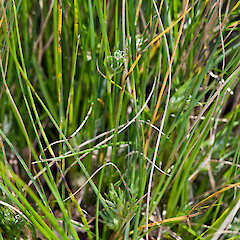Carex resectans
Common name
desert sedge
Synonyms
Carex inversa R.Br. var. radiata Cheeseman
Family
Cyperaceae
Flora category
Vascular – Native
Endemic taxon
Yes
Endemic genus
No
Endemic family
No
Structural class
Sedges
NVS code
The National Vegetation Survey (NVS) Databank is a physical archive and electronic databank containing records of over 94,000 vegetation survey plots - including data from over 19,000 permanent plots. NVS maintains a standard set of species code abbreviations that correspond to standard scientific plant names from the Ngä Tipu o Aotearoa - New Zealand Plants database.
CARRES
Chromosome number
2n = 58-60
Current conservation status
The conservation status of all known New Zealand vascular plant taxa at the rank of species and below were reassessed in 2017 using the New Zealand Threat Classification System (NZTCS) – more information about this can be found on the NZTCS website. This report includes a statistical summary and brief notes on changes since 2012 and replaces all previous NZTCS lists for vascular plants.
Please note, threat classifications are often suggested by authors when publications fall between NZTCS assessment periods – an interim threat classification status has not been assessed by the NZTCS panel.
- Conservation status of New Zealand indigenous vascular plants, 2017 . 2018. Peter J. de Lange, Jeremy R. Rolfe, John W. Barkla, Shannel P. Courtney, Paul D. Champion, Leon R. Perrie, Sarah M. Beadel, Kerry A. Ford, Ilse Breitwieser, Ines Schönberger, Rowan Hindmarsh-Walls, Peter B. Heenan and Kate Ladley. Department of Conservation. Source: NZTCS and licensed by DOC for reuse under the Creative Commons Attribution 4.0 International licence.
2017 | Not Threatened
Previous conservation statuses
2012 | Not Threatened
2009 | Not Threatened
2004 | Not Threatened
Distribution
Endemic. New Zealand: North and South Islands. Mainly easterly and uncommon in the North Island where it found from about the Hawke’s Bay south.
Habitat
Coastal to alpine. Usually on consolidated sand and alluvium in free draining usually very dry (though often seasonally flooded) habitats in short-tussock grassland, rough pasture, or in river beds or lake margins.
Wetland plant indicator status rating
Information derived from the revised national wetland plant list prepared to assist councils in delineating and monitoring wetlands (Clarkson et al., 2021 Manaaki Whenua – Landcare Research Contract Report LC3975 for Hawke’s Bay Regional Council). The national plant list categorises plants by the extent to which they are found in wetlands and not ‘drylands’. The indicator status ratings are OBL (obligate wetland), FACW (facultative wetland), FAC (facultative), FACU (facultative upland), and UPL (obligate upland). If you have suggestions for the Wetland Indicator Status Rating, please contact: [Enable JavaScript to view protected content]
FAC: Facultative
Commonly occurs as either a hydrophyte or non-hydrophyte (non-wetlands).
Detailed description
Rhizomatous; yellow-green to dark green sedge, usually forming a dense sward, or small circular patches. Rhizome 1.0–1.5 mm diameter, woody, much-branched, long-creeping, with shoots spaced singly and evenly along it, c. 1 mm diameter at base. Culms 5–40 mm tall, completely hidden by the leaf-sheaths; basal sheaths light grey-brown or chestnut. Leaves much > culms, 20–100 × c. 0.5 mm, plano-convex towards the tip, involute towards the base, wiry, margins scabrid especially towards the long trigonous tip. Inflorescence a pale green, compact head, 4–8 mm long, orbicular-ovate, with 1–3 crowded spikes, subtended by 2–3 leaf-like bracts. Spikes androgynous, few-flowered, male flowers 1–3 at base of spike, occasionally 0, female flowers 3–8. Glumes < or rarely = utricles, ovate or ovate-lanceolate, acuminate, hyaline, keel stout, green, 1-3-nerved. Utricles 3–4 × 1.5–2.0 mm, plano-convex, prominently nerved, light brown; contracted above to a narrow green beak c. 1.5 mm long, margins minutely toothed, orifice bifid; stipe not markedly contracted, c. 0.1 mm long. Stigmas 2. Nut c. 1.5 mm long, plano-convex, obovoid to almost orbicular, brown, shining, shortly stipitate.
Similar taxa
Carex resectans is most similar to C. colensoi Boott and C. inversa R.Br. two other densely tufted, grass-like species from which it is easily distinguished by the long-creeping rhizome with the shoots spread evenly along it, culms sheathed by leaves for almost their entire length, few-flowered, minute inflorescences which are usually obscured within the surrounding foliage, and light brown nuts with a pale green, minutely toothed beak.
Flowering
October–December
Fruiting
November–April
Life cycle
Nuts surrounded by inflated utricles are dispersed by granivory and wind (Thorsen et al., 2009).
Propagation technique
Easily grown from the division of whole plants and from fresh seed. Best suited for a well drained, sunny site in dry climates. This species dislikes humidity and soon dies if kept to moist.
Etymology
carex: Latin name for a species of sedge, now applied to the whole group.
Attribution
Fact Sheet prepared for NZPCN by P.J. de Lange (10 August 2006). Description adapted from Moore and Edgar (1970)
References and further reading
Moore LB, Edgar E. 1970. Flora of New Zealand, Volume II. Indigenous Tracheophyta: Monocotyledones except Gramineae. Government Printer, Wellington, NZ. 354 p.
Thorsen MJ, Dickinson KJM, Seddon PJ. 2009. Seed dispersal systems in the New Zealand flora. Perspectives in Plant Ecology, Evolution and Systematics 11: 285–309.
NZPCN Fact Sheet citation
Please cite as: de Lange, P.J. (Year at time of access): Carex resectans Fact Sheet (content continuously updated). New Zealand Plant Conservation Network. https://www.nzpcn.org.nz/flora/species/carex-resectans/ (Date website was queried)





